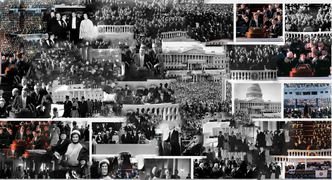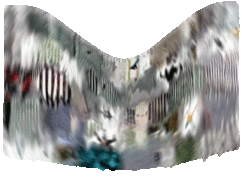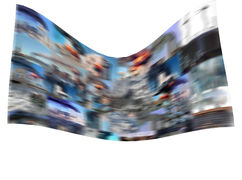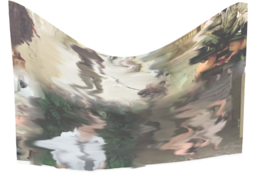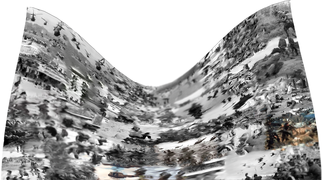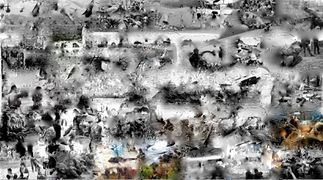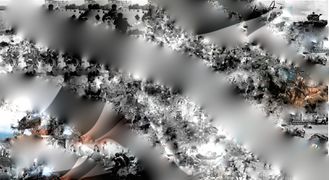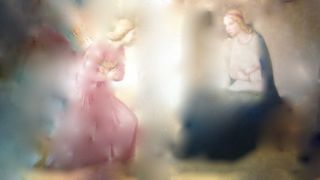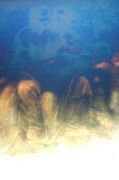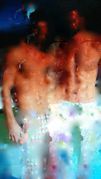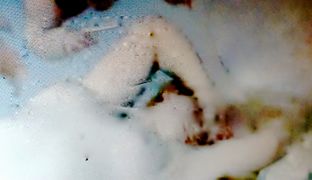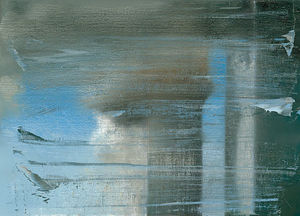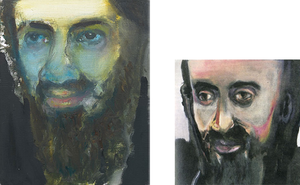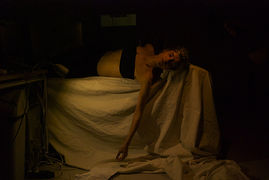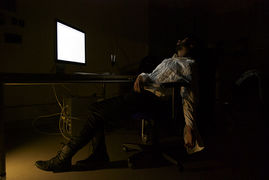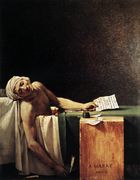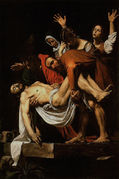Artyom proposal draft: Difference between revisions
No edit summary |
No edit summary |
||
| Line 1: | Line 1: | ||
Artyom - project proposal | |||
My graduation project is evolving around | My graduation project is evolving around exploring different image-making techniques, as well as understanding the peculiarities of the contemporary visual culture, in particular image culture - the two dimensional world of images. In my practice the past year I worked mostly with photography and recently I started working with re-photography and digital manipulation techniques, such as taking photos from existing images and manipulating them in different softwares (photoshop, iPhoto). In these latest experiments I’m interested in the specificity of the mediums that are used to make and view images. For example re-photography done from a computer screen differs from one that is done from printed photography or from a beamed projection, as well as the type of camera that is used to do the re-photography: mobile phone or DSLR camera. In this process I’m interested in how can existing images be used to ‘build’ new images and how they change their meaning by going through this transformations. For example an image that has been re-photographed from a computer screen and then printed on paper, where each medium specificity is layered on top of another (example 1-4). Besides this I did several experiments in ‘building’ new images from existing ones in more literal sense, by taking screen-shots from Google Image results and using them as raw material for my images (example 5-8). | ||
| Line 27: | Line 28: | ||
</gallery> | </gallery> | ||
I forsee my graduation project as an installation where I can create the space, both physically and metaphorically, where these different type of images can engage in a dialogue with each other. It will consist of collection of images; my ‘own’ images, images that are ‘built’ on others (re-photography, digital manipulation) as well as exciting images, such as iconic images. The dialogue between images has to be both in their content and as well the way they are displayed in space. For example it can be an installation where 3 beamers projecting images on 3 walls. Each projection is on slideshow mode, each seth of 3 images can have certain associations with one another and create a context where each of them can be seen. However the slideshows dosen’t have to change simultaneously, which can allow to create more diverse combination of images and therefore create a space where the same images can have different meanings. However I’m not limiting myself to projected images only and will consider using different mediums; print, screens and so on, depending on the type of image. | |||
The field of my interest is image culture, by that I mean the overall world of images from classical painting, to different field of photography, to advertising imagery one so on. I’m interested how images communicate as a medium, as well as how new technology offers different image-making techniques and how this affects on image culture. This culture although constituted by verity of mediums, I’ll be taking painting and photography as the case study for my research. Mostly because these two mediums are the primal mediums of image culture and therefore have diverse studies on them. And it will allow me to articulate with more concrete examples on the field that I’m researching. | |||
Our current image culture is formed around the photographic image which through the course of history came to establish itself as a medium that depicts the reality as it is. It gathered on itself the reputation of being ‘truthful’, ‘objective’ and has a power to stand as a ‘proof’ for something, to the degree that as a medium it has the monopoly on ‘documenting’ history. However not long after its emergence there has been studies that question those qualities . The articulation on photography’s questionable notions already starts from Benjamin’s “Work of Art” where he talks about how the world is experienced differently through the camera than through human eye and therefore its depiction of reality differs from one precived by humans. | |||
“Evidently a different nature opens itself to the camera than opens to the naked eye—if only because an unconsciously penetrated space is substituted for a space consciously explored by man. Even if one has a general knowledge of the way people walk, one knows nothing of a person’s posture during the fractional second of a stride. The act of reaching for a lighter or a spoon is familiar routine, yet we hardly know what really goes on between hand and metal, not to mention how this fluctuates with our moods. Here the camera intervenes with the resources of its lowerings and liftings, its interruptions and isolations, it extensions and accelerations, its enlargements and reductions. The camera introduces us to unconscious optics as does psychoanalysis to unconscious impulses.”1 | |||
Since Benjamin there have been number of studies that deepened the understanding on this notion, such us Media Theories where the ‘false objectivity' of photography has been a recurring subject. The general attitude of these studies toward photography is that rather then depicting the reality as it is, photography produces a ‘high degree of naturalistic illusion’. Photography rather than documenting, transforms the reality into an image - into its own reality. This notions opened up number of questions, at least in regards to photography’s position to ‘document’ history, such as ‘Can photography document history truthfully?’. However with the rise of media and its ability to create iconic images it became more obvious that some images ‘made history’ rather than document it. Consequently questions such as “Can photography produce history?’ came to arise. | |||
In both of these works there is confrontation between two semiotics of painting and photography. | [[File:Artyom-pp-8.jpeg|thumbnail|September - G.Richter]] [[File:Artyom-pp-9.png|thumbnail|right|Osama and Pilgrim - M.Dumas]] | ||
Within this context I see the works and the position of the contemporary painters such as Marlene Dumas, Gerhard Richter an so on. Working from existing images as source (mostly from photography) these painters already operate within the two-dimensionality of image rather than in the three dimensions of physical reality. Therefore their work is concerned with the image-reality rather than our reality. Although these artists operate in different areas of image culture, from iconic - media images to generic amateur photography, there are some crossways that their works meet. Richter’s “September” and Dumas’ two paintings of Bin Laden, “Osama” and “The Pilgrim”, are such examples. In this particular case these paintings are ‘build’ on an iconic photograph that ‘made history’. | |||
In both of these works there is confrontation between two semiotics of painting and photography. The paint does not simply represent the subject but it comes to question it. It takes the role of ‘other’ which comes question the ‘certainty’ of photography with its ‘ambiguity’. In other words these painters use the representational licence of painting to question the faculties of photography. | |||
Where Richter takes an image that has been fetishised by photography and physically scrapes away its symbolism, leaving vaguely recognisable elements merge with abstraction, Dumas’ two portraits of Bin Laden, that have been painted from the same source ( usually presented next to each other) show the alternative connotations that the original image could’ve have. In both cases these new images attempt to give us an other possible view on those iconic images that come to define our history and culture. | |||
I’m particularly interested how in this process the new images create their own meanings. They don’t simply takes their meaning from the original (photography) but from the matter that constitutes it - in other words the meaning derives from the gesture rather than what is depicted. These images are ‘built’ on others but rather than having only a referential position towards the original they transform the original and in this process create new meanings. | |||
Around these ideas I’m organising my current practise and research. My main question at this point will be ‘how can photography comment on itself - be its own ‘other’?’ As well I have few questions regarding the notions of reference within the image culture, such as ‘how can an image that is ‘built’ on another go beyond the ‘reference’. | |||
Past summer I did several try outs where I was using classical painting as starting point for photography. While this process is the opposite of what contemporary painters are doing and has different challenges, nevertheless it brought me to the problematic are of ‘reference’. This challenge seemed more problematic for me in photography exactly because of its ‘objective’ notion as a medium. In other words photography struggles to be the ‘other’ because it claims to be ‘the thing itself’ which increases the chance to be read simply as a ‘reference’. In this particular work my starting point was the image of “Death of Marat” by David. Where my first try outs were more of a literal representation - ‘references’, the later images manage to take a step further from the original and have a meanings of its own. In this process of ‘building’ an image on another I was struggling to have a balance between being too referential and excluding the original image entirely. My approach to this problem was to make my reference less literal, in formal (visual) sense, as in the first try outs but to make the reference more associative. For example using contemporary clothing but styling them in a way that it vaguely reassembles the 18th century costume - the time period of this painting. Furthermore I tried to not refer exactly to this painting but to have a light that is ‘painterly’, at the end keeping only the ‘hanging hand’ from the original sours. In regards to the attributes such as the computer screen or the ‘backstage’ elements of computer wires and so on, I used them again as balancing tool between painting and photography. Namely by using technology as an association to ‘modern’ in order to keep the image in the ‘photographic world’, not allowing it to fall into the ‘world of painting’ where it will become a simple reference to a classical image. | |||
| Line 71: | Line 77: | ||
In regards to the larger, theoretical context I’ll be looking into | In regards to the larger, theoretical context I’ll be looking into C.Shannon’s “A Mathematical Theory of Communication” (1948) which came to be a turning point for many disciplines across culture. Shannon’s proposed unit to calculate information - ‘bit’, made it possible to calculate everything around us as information. This new way of seeing the world also enabled to examine things in a different way, including images and art in general. I’m particularly interested in theories of Vilem Flusser - media theorist of late 20th century, who was one among many that uses Flusser’s two books “Towards a Philosophy of Photography” (1984) and “Universe of technical Images”(1985) are concerned with images in our technological age. In them he analyses images as medium and looks into their peculiarities as communication tools. Where in his first book Flusser looks at the overall history of images, from cave paintings to photography (still analog at the time), in the second book he concentrates on ‘technical’ images which can be understood in todays terms as digitally produced images. By taking into account the technological aspect, Flusser and media theory in general, make is possible to talk about images in more primal level, namely their actual construction (formation). Besides Flusser I’m interested in the theories of Umberto Eco - a semiotician who also uses Shannon’s theory as a base for his writings. He borrows Shannon’s terms: ‘message’, ’noise’, ‘redundancy’ to articulate on visual art. Where the ‘message’ is the information that is carried by the image, the ‘noise’ is its inherit quality that distorts the message and ‘redundancy’ is the solution against the ‘noise’, by repeating - reaffirming the message. In his book “Open Work” (1962) Eco speaks of ‘openness’ of visual art, which can be described as deliberately allowing ‘noise’ into the ‘message’. This, Eco claims, is done by the artists in order to step away from giving to an image specific meaning (which would be ‘redundant’) and ‘opening it up’ for multiple meanings and interpretations. In this light Eco sees a ’successful’ work as one than allows a maximum amount of ‘noise’ but it’s still manages to carry a ‘message’ - its ‘openness’ is at maximum but nevertheless in not a ‘white noise’ where there is no message left at all. | ||
In regards to the practical steps I’ve already began to print some of my images to see how they look ‘outside the screen. As well as I’m planning to start creating prototype installations using beamers and screens. As for the thesis, I see it as the place where my theoretical investigation can meet my practice. At this point I already see how my research affects on my practice, the thesis can be the place where I can articulate on both them. Besides my own writing I’d like to include few interview as a part of the thesis. These interviews can be conducted with artists from different disciplines, in which we can choose a specific topic of conversation such as the notion of ‘reference’ in art and so on. I have use the interview format in my previous writing and it has proven to be the convenient format to communicate my thoughts in less formal way. | |||
Revision as of 15:04, 27 November 2014
Artyom - project proposal
My graduation project is evolving around exploring different image-making techniques, as well as understanding the peculiarities of the contemporary visual culture, in particular image culture - the two dimensional world of images. In my practice the past year I worked mostly with photography and recently I started working with re-photography and digital manipulation techniques, such as taking photos from existing images and manipulating them in different softwares (photoshop, iPhoto). In these latest experiments I’m interested in the specificity of the mediums that are used to make and view images. For example re-photography done from a computer screen differs from one that is done from printed photography or from a beamed projection, as well as the type of camera that is used to do the re-photography: mobile phone or DSLR camera. In this process I’m interested in how can existing images be used to ‘build’ new images and how they change their meaning by going through this transformations. For example an image that has been re-photographed from a computer screen and then printed on paper, where each medium specificity is layered on top of another (example 1-4). Besides this I did several experiments in ‘building’ new images from existing ones in more literal sense, by taking screen-shots from Google Image results and using them as raw material for my images (example 5-8).
I forsee my graduation project as an installation where I can create the space, both physically and metaphorically, where these different type of images can engage in a dialogue with each other. It will consist of collection of images; my ‘own’ images, images that are ‘built’ on others (re-photography, digital manipulation) as well as exciting images, such as iconic images. The dialogue between images has to be both in their content and as well the way they are displayed in space. For example it can be an installation where 3 beamers projecting images on 3 walls. Each projection is on slideshow mode, each seth of 3 images can have certain associations with one another and create a context where each of them can be seen. However the slideshows dosen’t have to change simultaneously, which can allow to create more diverse combination of images and therefore create a space where the same images can have different meanings. However I’m not limiting myself to projected images only and will consider using different mediums; print, screens and so on, depending on the type of image.
The field of my interest is image culture, by that I mean the overall world of images from classical painting, to different field of photography, to advertising imagery one so on. I’m interested how images communicate as a medium, as well as how new technology offers different image-making techniques and how this affects on image culture. This culture although constituted by verity of mediums, I’ll be taking painting and photography as the case study for my research. Mostly because these two mediums are the primal mediums of image culture and therefore have diverse studies on them. And it will allow me to articulate with more concrete examples on the field that I’m researching. Our current image culture is formed around the photographic image which through the course of history came to establish itself as a medium that depicts the reality as it is. It gathered on itself the reputation of being ‘truthful’, ‘objective’ and has a power to stand as a ‘proof’ for something, to the degree that as a medium it has the monopoly on ‘documenting’ history. However not long after its emergence there has been studies that question those qualities . The articulation on photography’s questionable notions already starts from Benjamin’s “Work of Art” where he talks about how the world is experienced differently through the camera than through human eye and therefore its depiction of reality differs from one precived by humans.
“Evidently a different nature opens itself to the camera than opens to the naked eye—if only because an unconsciously penetrated space is substituted for a space consciously explored by man. Even if one has a general knowledge of the way people walk, one knows nothing of a person’s posture during the fractional second of a stride. The act of reaching for a lighter or a spoon is familiar routine, yet we hardly know what really goes on between hand and metal, not to mention how this fluctuates with our moods. Here the camera intervenes with the resources of its lowerings and liftings, its interruptions and isolations, it extensions and accelerations, its enlargements and reductions. The camera introduces us to unconscious optics as does psychoanalysis to unconscious impulses.”1
Since Benjamin there have been number of studies that deepened the understanding on this notion, such us Media Theories where the ‘false objectivity' of photography has been a recurring subject. The general attitude of these studies toward photography is that rather then depicting the reality as it is, photography produces a ‘high degree of naturalistic illusion’. Photography rather than documenting, transforms the reality into an image - into its own reality. This notions opened up number of questions, at least in regards to photography’s position to ‘document’ history, such as ‘Can photography document history truthfully?’. However with the rise of media and its ability to create iconic images it became more obvious that some images ‘made history’ rather than document it. Consequently questions such as “Can photography produce history?’ came to arise.
Within this context I see the works and the position of the contemporary painters such as Marlene Dumas, Gerhard Richter an so on. Working from existing images as source (mostly from photography) these painters already operate within the two-dimensionality of image rather than in the three dimensions of physical reality. Therefore their work is concerned with the image-reality rather than our reality. Although these artists operate in different areas of image culture, from iconic - media images to generic amateur photography, there are some crossways that their works meet. Richter’s “September” and Dumas’ two paintings of Bin Laden, “Osama” and “The Pilgrim”, are such examples. In this particular case these paintings are ‘build’ on an iconic photograph that ‘made history’. In both of these works there is confrontation between two semiotics of painting and photography. The paint does not simply represent the subject but it comes to question it. It takes the role of ‘other’ which comes question the ‘certainty’ of photography with its ‘ambiguity’. In other words these painters use the representational licence of painting to question the faculties of photography. Where Richter takes an image that has been fetishised by photography and physically scrapes away its symbolism, leaving vaguely recognisable elements merge with abstraction, Dumas’ two portraits of Bin Laden, that have been painted from the same source ( usually presented next to each other) show the alternative connotations that the original image could’ve have. In both cases these new images attempt to give us an other possible view on those iconic images that come to define our history and culture.
I’m particularly interested how in this process the new images create their own meanings. They don’t simply takes their meaning from the original (photography) but from the matter that constitutes it - in other words the meaning derives from the gesture rather than what is depicted. These images are ‘built’ on others but rather than having only a referential position towards the original they transform the original and in this process create new meanings. Around these ideas I’m organising my current practise and research. My main question at this point will be ‘how can photography comment on itself - be its own ‘other’?’ As well I have few questions regarding the notions of reference within the image culture, such as ‘how can an image that is ‘built’ on another go beyond the ‘reference’.
Past summer I did several try outs where I was using classical painting as starting point for photography. While this process is the opposite of what contemporary painters are doing and has different challenges, nevertheless it brought me to the problematic are of ‘reference’. This challenge seemed more problematic for me in photography exactly because of its ‘objective’ notion as a medium. In other words photography struggles to be the ‘other’ because it claims to be ‘the thing itself’ which increases the chance to be read simply as a ‘reference’. In this particular work my starting point was the image of “Death of Marat” by David. Where my first try outs were more of a literal representation - ‘references’, the later images manage to take a step further from the original and have a meanings of its own. In this process of ‘building’ an image on another I was struggling to have a balance between being too referential and excluding the original image entirely. My approach to this problem was to make my reference less literal, in formal (visual) sense, as in the first try outs but to make the reference more associative. For example using contemporary clothing but styling them in a way that it vaguely reassembles the 18th century costume - the time period of this painting. Furthermore I tried to not refer exactly to this painting but to have a light that is ‘painterly’, at the end keeping only the ‘hanging hand’ from the original sours. In regards to the attributes such as the computer screen or the ‘backstage’ elements of computer wires and so on, I used them again as balancing tool between painting and photography. Namely by using technology as an association to ‘modern’ in order to keep the image in the ‘photographic world’, not allowing it to fall into the ‘world of painting’ where it will become a simple reference to a classical image.
In regards to the larger, theoretical context I’ll be looking into C.Shannon’s “A Mathematical Theory of Communication” (1948) which came to be a turning point for many disciplines across culture. Shannon’s proposed unit to calculate information - ‘bit’, made it possible to calculate everything around us as information. This new way of seeing the world also enabled to examine things in a different way, including images and art in general. I’m particularly interested in theories of Vilem Flusser - media theorist of late 20th century, who was one among many that uses Flusser’s two books “Towards a Philosophy of Photography” (1984) and “Universe of technical Images”(1985) are concerned with images in our technological age. In them he analyses images as medium and looks into their peculiarities as communication tools. Where in his first book Flusser looks at the overall history of images, from cave paintings to photography (still analog at the time), in the second book he concentrates on ‘technical’ images which can be understood in todays terms as digitally produced images. By taking into account the technological aspect, Flusser and media theory in general, make is possible to talk about images in more primal level, namely their actual construction (formation). Besides Flusser I’m interested in the theories of Umberto Eco - a semiotician who also uses Shannon’s theory as a base for his writings. He borrows Shannon’s terms: ‘message’, ’noise’, ‘redundancy’ to articulate on visual art. Where the ‘message’ is the information that is carried by the image, the ‘noise’ is its inherit quality that distorts the message and ‘redundancy’ is the solution against the ‘noise’, by repeating - reaffirming the message. In his book “Open Work” (1962) Eco speaks of ‘openness’ of visual art, which can be described as deliberately allowing ‘noise’ into the ‘message’. This, Eco claims, is done by the artists in order to step away from giving to an image specific meaning (which would be ‘redundant’) and ‘opening it up’ for multiple meanings and interpretations. In this light Eco sees a ’successful’ work as one than allows a maximum amount of ‘noise’ but it’s still manages to carry a ‘message’ - its ‘openness’ is at maximum but nevertheless in not a ‘white noise’ where there is no message left at all.
In regards to the practical steps I’ve already began to print some of my images to see how they look ‘outside the screen. As well as I’m planning to start creating prototype installations using beamers and screens. As for the thesis, I see it as the place where my theoretical investigation can meet my practice. At this point I already see how my research affects on my practice, the thesis can be the place where I can articulate on both them. Besides my own writing I’d like to include few interview as a part of the thesis. These interviews can be conducted with artists from different disciplines, in which we can choose a specific topic of conversation such as the notion of ‘reference’ in art and so on. I have use the interview format in my previous writing and it has proven to be the convenient format to communicate my thoughts in less formal way.

